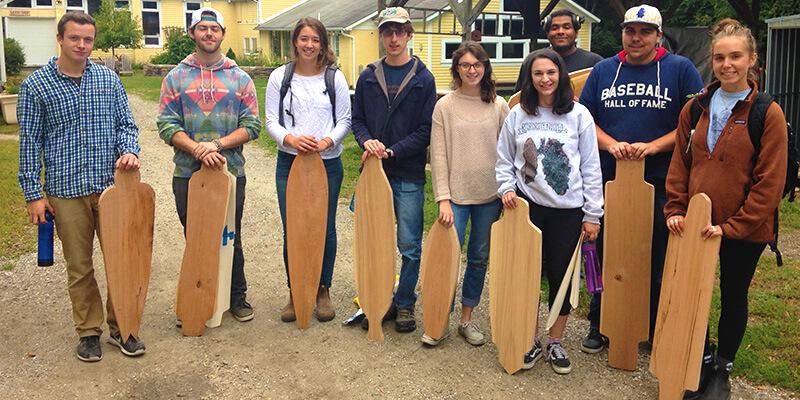What do nine University of Vermont students from five different colleges on campus all have in common? As residents of Greenhouse Residential Learning Community, they each designed and built a longboard as part of Director Walter Poleman’s Ecological Citizenship course (NR 16) held during fall semester 2016.
“This experience epitomized the goals of the GreenHouse Program’s Ecological Citizenship course: connecting our students to local places, local materials, and especially local mentors to learn skills that will serve them for a lifetime,” said Poleman, a faculty member in the Rubenstein School of Environment and Natural Resources (RSENR). His course is part of his student-centered Ecological Design Collaboratory supported by funding from the Henry David Thoreau Foundation.
“Building this board was one of the best experiences I’ve ever had in school,” said sophomore Nick Fontaine, neuroscience major in the College of Arts and Sciences (CAS). “It has such a simplistic beauty to it, as well as a utilitarian use in transportation from A to B. In making this board I not only gained a cool new board, but a great life story.”
The students worked under the mentorship of Bruce Beeken, Vermont furniture maker and fine wood craftsman, and co-instructor Victor Davila, junior in the Rubenstein School of Environment and Natural Resources and expert in the form and function of longboards.
“I liked being part of the student's foray into craftsmanship,” said Beeken, a longtime community partner with Poleman and the Rubenstein School. “Each longboard came about through a series of new risks and discoveries. I believe this experience will be carried over to other aspects of the student's lives.”
“Creating my longboard was physically and emotionally exhausting, but also extremely rewarding,” said Jennifer Van Voorhees, an animal sciences sophomore in the College of Agriculture and Life Sciences. “I am so happy I took this class – I learned about myself, tools that I have never seen or used before, and the process of woodworking to create something that is truly my own.”
The students built their longboards from black cherry, red oak, and white ash trees grown and harvested under the stewardship of Marshall Webb of Shelburne Farms in Shelburne, Vermont.
“My board is made of black cherry and the design was inspired and obtained by directly following the pattern of heartwood,” said sophomore Sophie Hodson who is majoring in mechanical engineering in the College of Engineering and Mathematical Sciences (CEMS). “It was an amazing experience to transform this raw wood into something so personal and unique.”
Webb stored the rough-cut boards in the historic Dairy Barn at Shelburne Farms where, in September, the students selected their planks to best fit the longboard each had in mind.
“Creating this longboard has broadened my appreciation for the privilege to utilize the beautiful services and materials that the environment creates and provides,” said Meghan Conway, environmental studies sophomore in CAS. “The entire process of creating a utility from a natural material has strengthened the respect and connection I feel I have with the natural world, and has left me with a clearer perspective on the true beauty and extraordinary characteristics of the natural world.”
Early in the morning of September 11, 2016, the very day after the students hauled away their chosen boards, a lightning-caused fire completely destroyed the Dairy Barn. Built in 1891, the historic Barn held lumber from 38 species of trees that grew at Shelburne Farms. The wood waited to be transformed into furniture and the barn into a new residential learning center. The boards the students chose represented the last from an entire generation of trees.
“Building my longboard gave me the opportunity to take something from nature and turn it into a piece of art,” said Christian Albright, sophomore in the Grossman School of Business. “The boards are a special piece of our environment and the fire at Shelburne Farms made them priceless.”
Victor chose to create a black cherry longboard to present to Webb in gratitude for his contribution to the class and in memory of the old Dairy Barn and the last of the lumber it had stored.
“Straight from the ruins of Shelburne, a steed worthy of only the bravest knight,” CAS sophomore Nick Cooke said of his longboard. “Crafted from Vermont's finest black cherry, this board originates directly from nature.”
The students drafted their initial longboard designs at Shelburne Craft School. After tracing their designs, the students band sawed their blanks from the original planks and then hand-shaped their boards.
“During the development of my board I was able to discover so much grace radiating from the process,” said Heidi Thorne, a sophomore in civil engineering from CEMS. “After the fire, the life of the wood became so very special in the hearts of many, and I was honored to be granted the opportunity of giving life back to the wood.”
The students planed the final cuts and sanded them to belly the underside of the boards, lighten them, and add style before varnishing.
My board may be made of white ash, but it will allow me to fly,” said Ben Greenberg, sophomore in environmental sciences from RSENR. “Making the longboard has given me an appreciation of the idea of ‘thusness’.”
The final creations are temporarily displayed in the atrium of the Rubenstein School’s Aiken Center.
